Definitely proving your marketing ROI is often thought of as a ‘nice-to-have’ for marketers. But that doesn’t have to be the case. We spoke to experts across industries to find out their take on definitively proving ROI.
As attribution experts, we had to talk about proving ROI.
It’s the must-have metric when it comes to marketing. Without it, you’re marketing blind.
So, we asked 21 experts for their tips and tricks when it comes to solidifying how your work is impacting your bottom line.
In this blog, we’ll go through:
So, let’s get started!
Think about how many channels you’re currently sharing content on.
It could be five, 10, 15 or more. With all of those channels, comes a whole lot of campaigns and ads and with that, a whole lot of data.
Related: How to measure marketing ROI
Julian Goldie, CEO at the Goldie Agency agreed, “A digital marketing drive makes use of various channels and strategies, and it can be challenging to recognize the net profit correlated with a single digital marketing tactic.”
Proving ROI isn’t a worldwide issue for every marketer though. For eCommerce, it can be much more straightforward to prove marketing’s impact.
Craig Zevin, COO at UberDoc commented, “eCommerce is the easiest because the time from ads to sales is the shortest and there isn’t as much human sales and support cost involved. B2B enterprise is the hardest because it has the longest cycles and the most human support requirements.”
⚡️ Pro Tip
Want to learn more about how users convert, industry to industry? Check out our conversion benchmark report here to see the full data.
Now we know how tricky it can be to prove your marketing ROI, let’s look at how to break down those barriers.
We asked industry experts for their top tips. Here’s what they suggested:
Let’s delve into each one in more detail.
Michael Steele, CEO of Flywheel Digital said, “Having comprehensive and accurate analytics set up is the first step to measuring and proving marketing ROI; you can’t measure what you don’t know.”
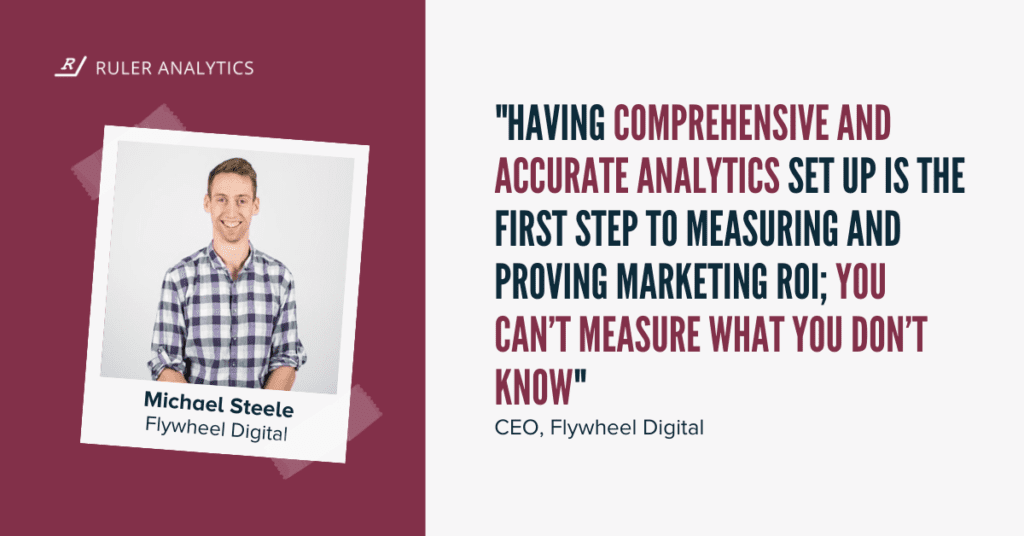
Kent Lewis, President and Founder of Anvil Media added, “The best way to definitively prove marketing ROI is through accurate measurement. Typically, this requires some form of pixel tracking, cookies and other methods (FLOC, Google Analytics & Ad tracking) and third-party analytics platforms. Each channel should be tagged and tracked to understand performance and ROI.”
Related: Best marketing ROI tools to try
Marco Baatjes, Founder and CEO of Caffeinated Face said, “The first thing to do to definitively prove your marketing ROI is to define your strategy. By actively creating goals for your marketing campaigns you’ll be able to measure your ROI effectively. This is because you’ll have a clear measurable target in which you can measure the success of a campaign. For example, when promoting a product with paid ads on Facebook or Instagram, a common goal to measure ROI is the purchase conversion. From this, you can measure your cost per purchase, compare past campaigns and determine if you are profitable or not. This is more effective than not having a strategy in place.”
Tim Clarke, Director of Sales and Marketing at SEOBlog.com said, “I’d say it starts by clearly defining your goal to make sure you move in the right direction. Understanding your goals will help you determine the failure and success of your campaign. Your marketing goals define your campaign’s success, attribute impact, and by the use of data, you will understand what you need to improve or refine. You can not manage what you can not measure! Everything should be data-driven and quantifiable to measure, so always tie your strategy to numbers. This will help you ensure that all the data is used to move you closer to your goals.
Once you identify your ROI of your sales funnel, it will help you determine the value of your marketing and sales efforts. It also provides a better understanding of what types of marketing efforts are worth your time.”
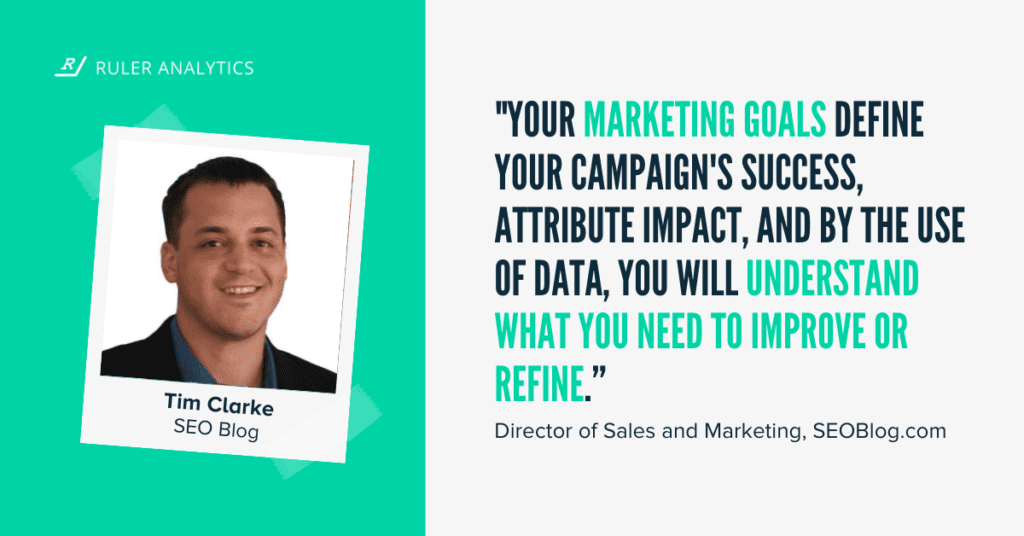
Todd Ramblin, Manager at Cable Compare said, “How can you know the success of anything if you don’t have tangible goals to measure your results against? You can’t. If you want to be able to show marketing ROI you need to have a strategy that contains a campaign plan, how you’ll execute the plan, timelines, cost, the expected results, and examples of similar campaigns with what they produced.”
Related: How to assign values to your goals in Google Analytics
Jenna Carson, Marketing & Sales Director at Music Grotto agreed, “The best action we’ve taken to arrive at a definite ROI figure from marketing activity each month has been to attach a financial figure to every KPI. We all know in marketing that some figures such as digital ad conversions are easier to track than most and that’s why we added costs to the likes of: social media impressions, customer loyalty, newsletter sign-ups etc.
“The value is based on average conversion rates and what we would pay for that lead or retention. Every month we have a clear overview of ROI and our marketing output is the best it’s ever been.”
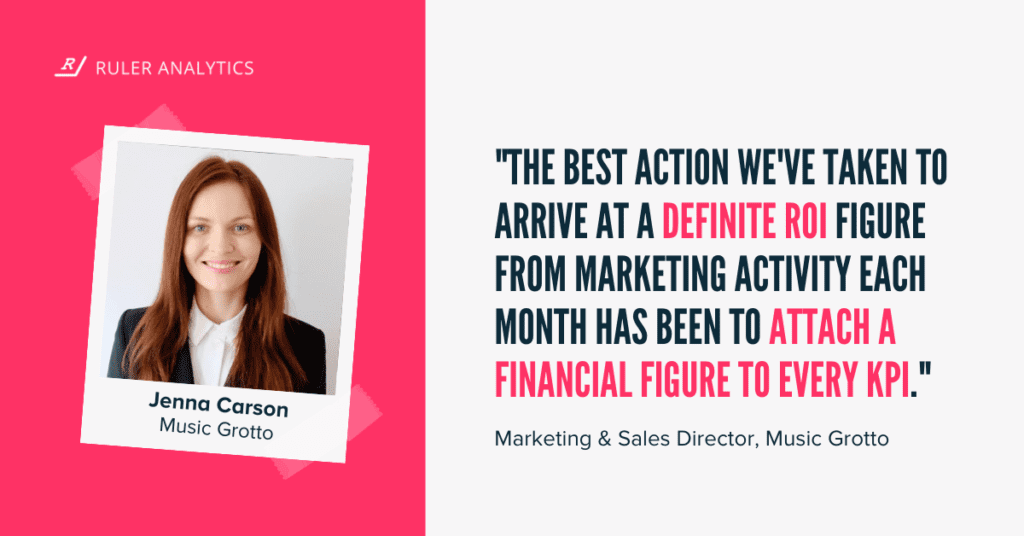
Katherine Garratt, Content Manager at Superfast IT said, “Ideally you need to collect a footprint of your customer’s journey, every step of the way. It’s impossible to do this without digital tracking in place.
Related: The role of a CRM in marketing
You need a CRM in place to save all of your lead data. Your website needs to link to your CRM. And your social posts need to link to your CRM. Your email marketing needs to link to your CRM. A CRM that links your lead and marketing data to marketing activity is a great way to better understand your ROI.”
Jimmy McMillan, Owner of Heart Life Insurance agreed with Katherine.
He added, “To prove marketing ROI with certainty you need a system for tracking your prospects all the way through the sales funnel, like a good CRM. We use a CRM, and with it, I can clearly define which marketing sources led to the most qualified prospects. Then I can add on the time my agents need to spend to make a sale, and finally, measure the investment in lead cost and agent time versus the gross sales from those prospects.
Related: How to integrate your CRM with Google Analytics for closed-loop reporting
As long as you clearly track these metrics, the numbers prove whether a marketing campaign is profitable or if you should shift your marketing investment elsewhere.”
Matt Lally, Founder of TheGiftYak said, “I can 100% without a shadow of a doubt say that the only way to prove ROI *to executives & founders* is with source data.
If you’re a marketer flying by the seat of their pants it doesn’t cut it in 2021.
You need to be able to attribute revenue and sign-ups to clicks on your ads, website and apps. If you’re a marketer worth your salt, you need to also be an analytics expert. You need to partner with the right providers and have the right infrastructure set up.”
⚡️ Pro Tip
Not sure how to link data from anonymous website users and your CRM? Read how to link your lead source to your CRM.
Roshni Wijayasinha, Founder and Chief Strategy Officer at Prosh Marketing said, “You can definitively prove ROI if you have proper lead source tracking and analytics implemented that track an entire customer journey. By being able to track where a closed customer comes from, you can calculate the value of that channel and determine the ROI of any spend.
“Leveraging CRMs can assist you in tracking a customer throughout this process, as well as after they have closed so that you can take into account their LTV (lifetime value) when calculating the ROI of any channel or marketing activity.”
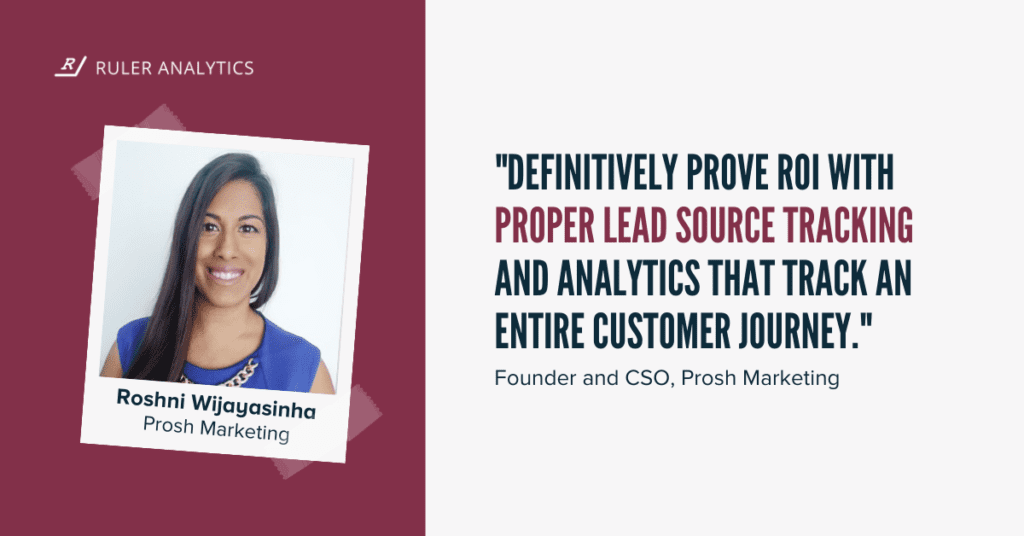
Ron Evan, Digital Marketing Specialist at Thrive Agency, said “I’ve seen people make all kinds of crazy convoluted assumptions to measure and “prove” marketing ROI. Marketers have so many places where the underlying data is unclear. Efforts to fill in those dark areas result in a final ROI measurement plan that is wildly unreliable.
Related: How to unlock revenue data in Google Analytics
“To do any useful marketing ROI measurement, you must have crystal clear visibility into all of your marketing metrics. Most businesses don’t because it’s not easy or quick to get there.
“You have to see everything that goes on in your marketing and your website, from the tiniest level of detail to the big picture. If you can’t, you will likely be measuring ROI in ways that are questionable at best.
“Once you have excellent marketing clarity, you’ll have the data and insights you need to more accurately measure ROI, no matter what type of digital marketing you’re doing.”
⚡️ Pro Tip
Tracking revenue isn’t always easy. Here’s how you can use our tool to track and forecast revenue to get deeper insights into what works, and what doesn’t.
Quincy Smith, Co-Founder at TEFL Hero said, “At the risk of sounding simplistic, marketing ROI doesn’t work without a defined, tested, and proven attribution model.
“This starts with naming conventions and definitions of marketing channels. Should a banner on an affiliate’s site be tagged as a referral or display? It also includes everything from funnel tracking to attribution modelling.
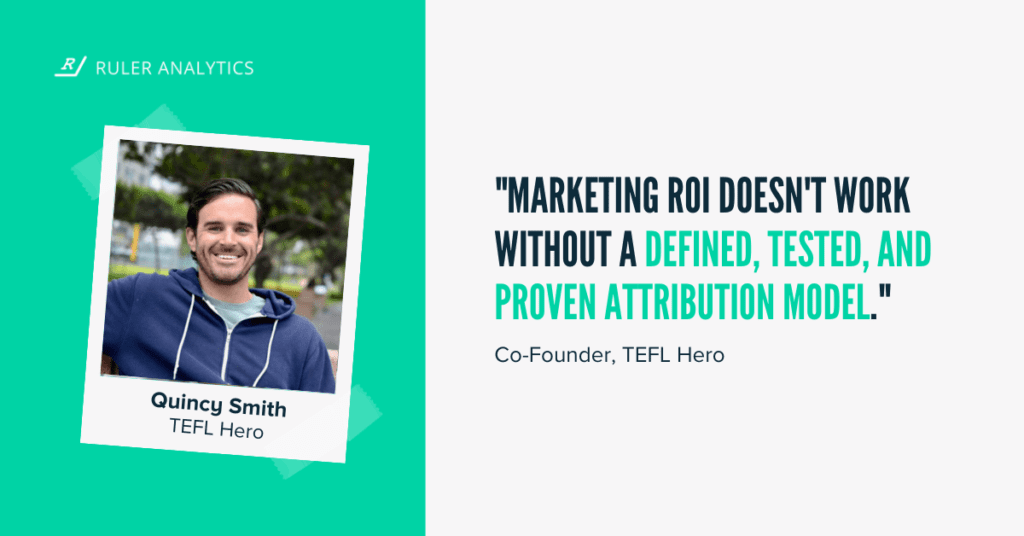
The easiest way to ensure your ROI is tracked consistently is to use UTM parameters religiously. First, define which naming conventions you’re going to use (and stick to them!).
Related: How to track links with UTM tagging
Then, go into your channel definitions within your Analytics platform and ensure planned parameters are mapped to the correct channel. Finally, when you run reports, use the same attribution model each time. This will add consistency so you can see what channels are contributing to revenue and what the common conversion paths are.
Once you have this you can easily compare it to your budget or spend to see which campaigns are paying off and which are coming up short.”
✏️ Note
In case you didn’t know, Ruler is a leader in marketing attribution. Learn exactly how Ruler can attribute closed revenue back to your marketing touchpoints.
Kelly Main, Senior Marketing Analyst at FitSmallBusiness added, “Definitely proving marketing ROI comes down to your bottom line.
“Return on investment, after all, is simply the amount of money earned per the money spent. Eliminate any of those fluffy marketing goals that fail to bridge revenue and ad spend. You know the ones such as views, clicks, likes, shares, or even leads generated. If you don’t have a direct way to measure the impact on sales from your goal, then it’s not a goal for increasing ROI. Of course, it’s not to say that these non-qualitative objectives aren’t valuable. However, they’re not valuable for those that need to have a solid grasp on ROI.”

Abby Herman, Director of Strategy at Snap Agency agreed, “It will depend on what it’s being marketed and what type of campaign I do. With that said, it’s very difficult to “definitely” prove marketing ROI because the investment we put in today could render results next month or even next year. However, we like to use both single attribution, and multi-touch attribution.”
Martynas Kavaliauskas, Co-founder and CEO at TrackingFox, “It might be difficult to measure marketing ROI because each lead might be touched by different marketing efforts before it converts to a sale. To definitely prove ROI, it is important to classify each sale as to where it came from and what particular marketing method was responsible for converting that lead.
Related: Complete guide to customer journey stages
“To do this, you need to have a system at hand that specifically addresses how to deal with sales that might have been touched by multiple marketing efforts. This will provide a standard on which the computation of ROI will be based from.”
Akshay Deogiri, SEO Outreach Specialist from Mobstac said, “Set goals and KPIs for each marketing channel. Measure data using different tracking codes across multiple channels, managed by Google Tag Manager. Track customer journey data across the marketing funnel, and create an empirical data funnel to track progress at different levels.”
Related: How to track full customer journeys
Cody Zucker, Founder and Owner of We Buy Jersey Shore Houses said, “A lot of companies look at Marketing ROI as Profit over Total Marketing Spend. This is misleading because it doesn’t address the true elephant in the room; what marketing dollars are specifically providing them with the most bang for their buck and hence where they should be throwing their budget for subsequent campaigns. True marketing ROI should be calculated based on profits and spends from individual marketing channels.”
Dave Smithbury, Head of Marketing at Ruler Analytics, agreed, “Marketing ROI is a catch-all metric. While you might have a positive ROI overall, this doesn’t mean everything you’re doing is working.
With marketing attribution tools, you can easily split out your marketing by channel, by campaigns, and even by ad to see what’s working best. It allows you to get more clinical with how you approach altering budgets, creating campaign strategies and selecting your priorities. Attribution is the missing piece of the puzzle that allows marketers to take time and get creative on the channels they know work best for them.”
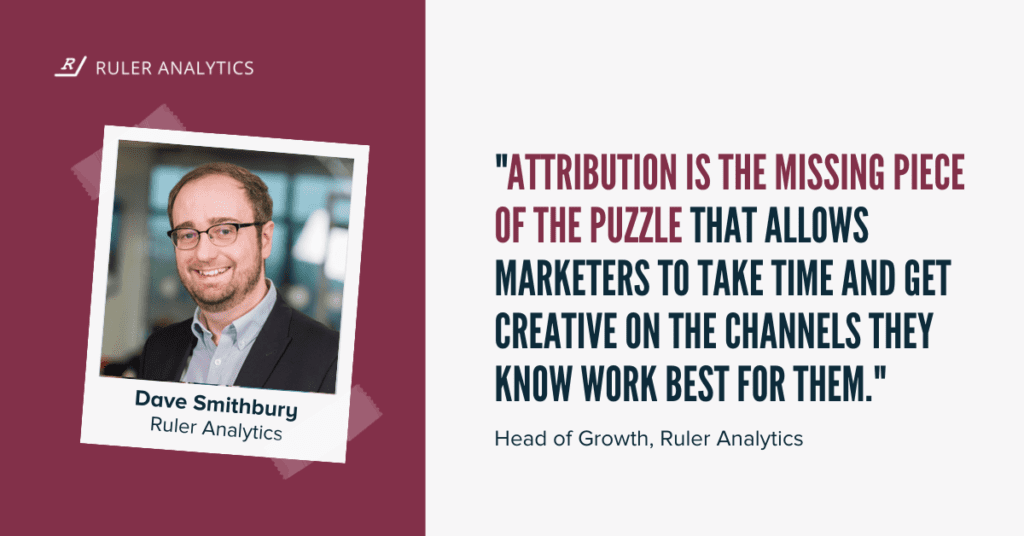
Adam Seaborn, Director of Sales and Media Operations at Kingstar Media said, “A DIY marketing mentality will only take you so far, at some point your brand will not have the bandwidth or experience to properly track and attribute all marketing activity. There are dozens of software tools to help, and experts who can help you make sense of where every marketing dollar goes and why.”
And that’s where we come in. You knew the sales pitch was coming, didn’t you?
We are a marketing attribution tool. We track every touchpoint and interaction.
It means you can see full customer journeys and understand the ways in which your marketing campaign and collateral work together.
If you want to learn more about how you can definitively prove your marketing ROI (and also optimise your marketing, view every lead and every touchpoint and so much more), then book a demo with our team to see Ruler in action.